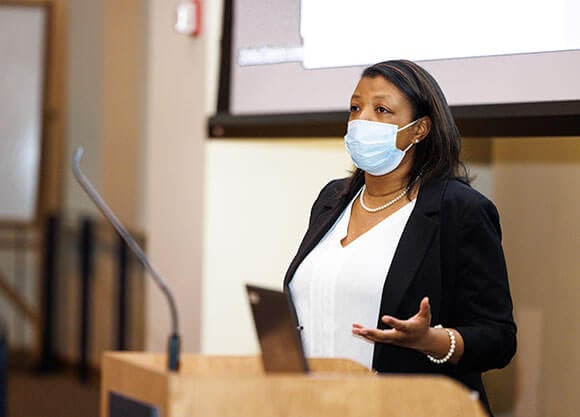
Reframing Black contribution to America’s indigenous society
March 01, 2022

March 01, 2022

Dickerson-Cousin is the author of “Black Indians and Freedmen: The African Methodist Episcopal Church and Indigenous Americans, 1816-1916.” The book explores the plight of formerly enslaved people forging a new life in a largely unwelcoming society in the post-Civil War era.
The African Methodist Church was founded in 1816 by Richard Allen, a formerly enslaved man who bought he and his brother’s freedom from Stokeley Sturgis. Sturgis was compelled to free the men after Allen brought a Methodist preacher to speak on Sturgis’ farm. Allen continued to work on the farm until he saved the required $2,000 and was emancipated in 1783.
Allen became a traveling preacher and eventually joined the St. George Methodist Episcopal Church in Philadelphia. The church still insisted on segregation, and Black worshippers were supposed to stay in a designated area, said Dickerson-Cousin. After Allen and his friends were physically made to move during prayer, he decided to find another way to worship.
“He was upset at the white’s behavior because it went against Methodists’ tradition of egalitarianism and inclusivity,” said Dickerson-Cousin.
Allen bought a lot at 6th and Lombard streets, which would eventually become the first African Methodist Episcopal (AME) Church. Later known as Mother Bethel, the church fostered a new denomination which would be declared independent from the Methodist Episcopal Church, said Dickerson-Cousin. Allen would become AME’s inaugural bishop.
“Allen hoped to correct what had gone wrong in the Methodist movement,” she said. “He wanted to institute racial and ethnic inclusivity and included indigenous people within his purview.”
Allen’s vision of inclusive worshipping would eventually make its way into the American West, formerly referred to as Indian Territory, said Dickerson-Cousin.
The 1830’s Indian Removal Act forced the indigenous people known as the Five Civilized Tribes to abandon their land in Georgia, Florida, North Carolina, Tennessee, Alabama, Mississippi and Arkansas. These areas hosted particularly fertile ground for cotton farming and were highly sought after by white settlers, she said.
Thousands of Native Americans traveled to their newly designated territory west of the Mississippi, which is now Oklahoma. Also making the treacherous trip along what is known as the Trail of Tears were their Black enslaved people.
“Cherokees, Creek, Choctaw, Chickasaw and Seminole tribes were considered civilized because they incorporated certain elements of European and American culture: Christianity, political structure and holding Black people as slaves,” said Dickerson-Cousin. “Indigenous masters tended to be wealthy people of native and European ancestry.”
Partly due to their vested interest in slavery, members of the Five Tribes supported the Confederacy and fought on their side during the Civil War.
“After the Confederacy lost, members of these tribes joined the United States and signed new treaties to reestablish a cordial relationship with each other,” said Dickerson-Cousin. “A treaty was signed in 1866 and compelled tribes to free slaves and adopt them as citizens in their nations. Now called Freedmen, they could travel and have land.”
Over time, Freedmen assumed indigenous cultures as their own and many learned English only after they were released from slavery. Annie Keel, a Black woman formerly enslaved by a Chickasaw mistress, survived the Trail of Tears and began a new family as a free woman with Billy Keel, with whom she had four children. She heard of AME and led efforts to bring the church west.
“Keel was impressed by the Black self-government of AME and that it had the Christian Recorder, its own newspaper, and its own higher education institution, Wilberforce University,” said Dickerson-Cousin. The Keels would host the first AME meeting in this new territory at their Yellow Springs home.
Several AME chapters soon emerged, spurring the creation of the Oklahoma Annual Conference. AME ministers performed the traditional duties for members, including baptisms, weddings and funerals, said Dickerson-Cousin.
The ministers would eventually play a more unique role as witnesses for their congregations. The General Allotment Act of 1887 broke up tribal lots of land to promote individual plots and a more nuclear family model. The Curtis Act of 1898 determined who was able to access these lands – including those who proved they were enslaved by indigenous people, as they could identify as indigenous and purchase land, she said.
“You’d have to prove you were enslaved by tribes and often AME preachers proved membership. People used birth, marriage and death records, along with the testimony of witnesses and personal testimony,” said Dickerson-Cousin. “20,000 Black Indians were placed on Freedmen rolls and entitled to citizenship and land rites.”
Undoubtedly, the continued work of AME is emulated by Richard Allen’s vision of more global inclusion.
“AME ministers performed crucial services for the Black Indian community and aiding Black Indians in tribal citizenship cases was among those services,” said Dickerson-Cousin.
“Black Indians and Freedmen: The African Methodist Episcopal Church and Indigenous Americans, 1816-1916” is published by the University of Illinois Press and is available for purchase here.
Quinnipiac Today is your source for what's happening throughout #BobcatNation. Sign up for our weekly email newsletter to be among the first to know about news, events and members of our Bobcat family who are making a positive difference in our world.
Sign Up Now